Treatment Options
Because of the potential complexity of rosacea, it has been classified into subtypes according to signs and symptoms that often occur together, and patients may have characteristics of more than one subtype at the same time. While your doctor will tailor medical therapy to your individual case, treatment options may often be keyed to standard subtypes and level of severity.
SUBTYPE 1 - Facial Redness
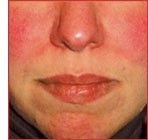 Subtype 1 (erythematotelangiectatic) rosacea is characterized by flushing and persistent facial redness. Visible blood vessels may also be present, and facial discomfort is common.
Subtype 1 (erythematotelangiectatic) rosacea is characterized by flushing and persistent facial redness. Visible blood vessels may also be present, and facial discomfort is common.
Because this subtype is difficult to treat with medical therapy, it may be especially important for you to identify and avoid lifestyle and environmental factors that trigger flushing or irritate your skin. This is discussed in detail under "Lifestyle Management."
The appearance of flushing, redness and visible blood vessels may also be concealed with cosmetics, and facial discomfort may benefit from appropriate skin care, both discussed under "Personal Care."
Visible blood vessels and severe background redness may be reduced with lasers or intense pulsed light therapy. Several sessions are typically required for satisfactory results, and touch-up sessions may later be needed as the underlying disease process is still present.
In specific cases, extensive flushing may be moderated somewhat through the use of certain drugs.
SUBTYPE 2 - Bumps and Pimples
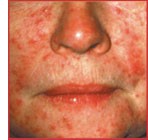 Subtype 2 (papulopustular) rosacea is characterized by persistent facial redness and acne-like bumps and pimples, and is often seen after or at the same time as subtype 1. Unlike subtype 1, however, a number of medications have been extensively studied and approved for this common form of rosacea, and may also be used on a long-term basis to prevent recurrence of symptoms.
Subtype 2 (papulopustular) rosacea is characterized by persistent facial redness and acne-like bumps and pimples, and is often seen after or at the same time as subtype 1. Unlike subtype 1, however, a number of medications have been extensively studied and approved for this common form of rosacea, and may also be used on a long-term basis to prevent recurrence of symptoms.
In mild to moderate cases, doctors often prescribe oral antibiotics and topical rosacea therapy to bring the condition under immediate control, followed by long-term use of the topical therapy alone to maintain remission. A version of an oral antibiotic with less risk of microbial resistance has also been developed specifically for rosacea and has been shown to be safe for long-term use.
In severe cases, higher doses of oral antibiotics may be prescribed, and other drugs may be used for patients who are unresponsive to conventional treatments.
SUBTYPE 3 - Skin Thickening
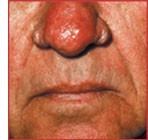 Subtype 3 (phymatous) rosacea is characterized by skin thickening and enlargement, most frequently around the nose. Although mild cases may be treated with medications, moderate to severe manifestations typically require surgery. A wide range of surgical options is available, and a surgical laser may be used as a bloodless scalpel to remove excess tissue and recontour the nose, often followed by dermabrasion.
Subtype 3 (phymatous) rosacea is characterized by skin thickening and enlargement, most frequently around the nose. Although mild cases may be treated with medications, moderate to severe manifestations typically require surgery. A wide range of surgical options is available, and a surgical laser may be used as a bloodless scalpel to remove excess tissue and recontour the nose, often followed by dermabrasion.
SUBTYPE 4 - Eye Irritation
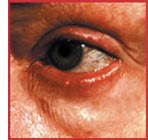 Subtype 4 (ocular) rosacea is characterized by any one of many eye symptoms, including a watery or bloodshot appearance, foreign body sensation, burning or stinging, dryness, itching, light sensitivity and blurred vision. A history of having styes is a strong indication, as well as having "dry eye" or blepharitis.
Subtype 4 (ocular) rosacea is characterized by any one of many eye symptoms, including a watery or bloodshot appearance, foreign body sensation, burning or stinging, dryness, itching, light sensitivity and blurred vision. A history of having styes is a strong indication, as well as having "dry eye" or blepharitis.
Treatment for mild to moderate ocular rosacea may include artificial tears, oral antibiotics and the daily cleansing of the eyelashes with baby shampoo on a wet washcloth. More severe cases should be examined by an eye specialist, who may prescribe ophthalmic treatments, as potential corneal complications may involve the loss of visual acuity.
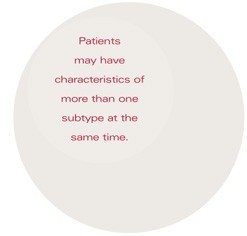
| Previous | Index | Next |